Pulsed UV light method aims to reduce allergens in peanuts
Aiming to make peanuts safer for people with peanut allergies, University of Florida (UF; Gainesville, FL) researchers have developed a method that uses pulsed UV light to reduce allergens in peanuts by up to 90%.
To accomplish this, the researchers released pulsed bursts of UV light containing multiple wavelengths. The UV light pulses change peanut allergens so that human antibodies canât recognize them and cause the release of histamines, which are responsible for allergy symptoms such as itching, rashes and wheezing.
âWe believe the allergen can be controlled at the processing stage, before the product even goes to the shelf,â says Wade Yang, an assistant professor in UFâs food science and human nutrition department.
Yang confirmed the allergy reduction using a biochemical test and by exposing the proteins to serum samples from patients with peanut allergies to see if an allergic reaction occurred.
Allergens were reduced in peanut extracts and peanut butter. Preliminary, unpublished results also demonstrate that pulsed UV light can significantly reduce the allergenic potential of whole peanuts.
Dr. Shih-Wen Huang, a pediatric allergist in UFâs College of Medicine, says that epinephrine is often recommended for treating severe allergic reactions, and for milder reactions, antihistamines. And while epinephrine and antihistamines alleviate allergenic symptoms, Yang says he would like to prevent the allergy at the processing stage with pulsed UV light before it reaches humans.
Yangâs future research involves developing a one-step roasting and allergen reduction process by pulsed UV light to produce hypoallergenic whole peanuts.
The study was published this week in the journal Food and Bioprocess Technology.
-----
Posted by Lee Mather
Follow us on Twitter, 'like' us on Facebook, and join our group on LinkedIn
Follow OptoIQ on your iPhone; download the free app here.
Subscribe now to BioOptics World magazine; it's free!

